Two Brits With Metal Detector Find Ancient Roman Bronze Artifacts

A dog statue with its tongue hanging out is one of many ancient Roman bronze artifacts uncovered in England that date back 1,700 years.
The numerous pieces are remnants of a time when the Roman Empire ruled Great Britain, during roughly the first four centuries AD, and may have been heaped together by a metal worker who was going to melt them down to reuse the material, the Gloucestershire City Council said when it reported the finds. Although the artifacts “appear to have been deliberately broken and hidden,” the dog statue is still whole and is an example of a healing statue. It may have been used at an undiscovered Roman healing temple in Gloucestershire or in a known temple in the town Lydney in that county.
Two men found the bronze treasure hoard with the help of a metal detector, the city council said. They contacted archaeologists who handled the pieces.
“How wonderful to have made such an astonishing discovery, and what a fantastic coup for Gloucestershire,” Councillor Nigel Moor, cabinet member for fire, planning and infrastructure, said in the city statement. “The prospect of more hidden treasures buried here in the county is an exciting one indeed for local residents and historians alike.”

The small dog statue is 8 inches long and more than 5 inches tall and shows a standing canine with a long torso. Its shoulders are decorated with patterns of ovals and chevrons to give the appearance of leaves or feathers, according to a database of the artifacts from the British Museum. “On the underside there is a large square hole in the stomach and its genitals are clearly displayed.”
Apart from the dog statue, the archaeologists also uncovered fragments of a large bronze statue that would have been between 3 feet and 4 feet tall, according to a description on the database. The fragments depict cloth, a shoulder that likely belonged to a woman, and a part of the face containing an eye and the side of a head, among other pieces from this one item.
Other items found included a fragment of a frying pan or skillet, a “face with curly hair, possibly from a vessel,” various animal heads and parts, jewelry, pieces of furniture and a coin, among many other pieces.

“The artifacts are of such significance that they need to be kept under special conditions for insurance reasons, and are currently being stored at Bristol museum, where they are being photographed and catalogued on an online database,” the city council reported. “Experts are piecing together the clues, and the findings will be presented by the British Museum at a launch event, likely to take place around the end of the year.”
The pair that found the artifacts, dating back to the 4th century, has been metal detecting for years.
“It’s not every day you come across a hoard of roman bronze,” Pete Cresswell, who discovered the ancient Roman pieces with his brother-in-law Andrew Boughton, said in the council statement. “As soon as I realized the items were of historical significance I contacted the local archaeology team, who were equally excited by the find. It’s a great privilege to be able to contribute to local and British history.”

© Copyright IBTimes 2025. All rights reserved.





















